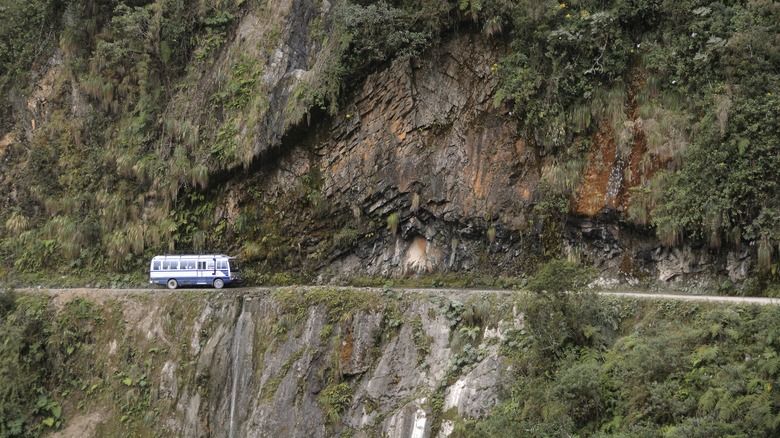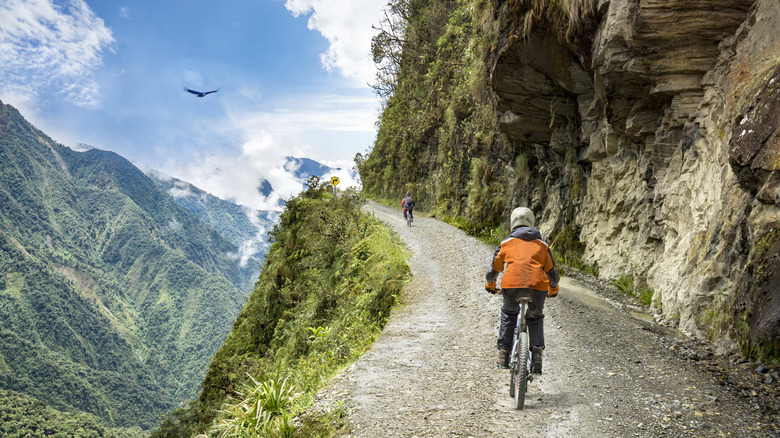Death Road: Possibly The World's Most Difficult Highway To Drive
It may sometimes feel perilous driving to work, especially if you have to cross some of the scariest roads in the United States, like Monarch Pass in Colorado or the Verrazzano-Narrows Bridge in New York. At least you aren't driving on a road that's so dangerous it's nickname is "Death Road," though. Located in Bolivia, Colombia, the "Camino de la Muerte," (Death Road), is carved into mountainous terrain. Only 37 miles long, it runs from the city of La Paz to the town of Coroico. It is infamous for its vertical cliffs, some with drop-offs of 2,000 feet, as well as blind curves and hairpin turns. The slopes are also unstable, leading to landslides, and in some places, the unpaved road narrows to less than 10 feet wide.
That means the road is barely wide enough for one vehicle, let alone two going in opposing directions. Guardrails are few, or completely non-existent according to some reports, and the road is often enveloped in rain and fog, making a perilous journey even more dangerous. It is certainly not a road for timid drivers, but for some thrill seekers, it remains the ultimate ride today.
The Death Road was once an important route
The Camino de la Muerte was built by Paraguayan prisoners of war after the end of the Chaco War in 1935. Its primary purpose was to connect the Yungas region and La Paz, which is historically the economic and political center of Bolivia and is the nation's administrative capital. Many of the prisoners died while constructing the road, and many more died in later years when trying to navigate it. In 2007, a paved bypass opened, allowing trucks and buses to stay off the Death Road and use the safer route instead. Before the bypass opened, however, it was estimated that between 200 and 300 people died on the Death Road every year.
Bolivians used the road to move goods between the highlands of La Paz and the lowlands. Before there was any alternative, the treacherous road didn't just see bicycles and cars, but large trucks and buses as well. The most dangerous U.S. roads for truck drivers and the most dangerous highways in general in the U.S. pale in comparison to the Death Road. Even worse, despite the fact that Bolivians drive on the right side of the road, this rule did not apply to the Death Road. Drivers have to use the left-hand side because it gives them a better view of the tire that is closest to the steep terrain and allows for easier passing when two vehicles going in opposing directions meet up.
The Death Road is still open today
With a safer route available, why would people opt to drive or ride on such a dangerous path? Since the early 2000s, the Death Road has transformed from a transportation route into a tourism destination. While some tourists still dare to tackle the road in a vehicle, many are there for a different thrill: cycling down the near 40 miles of infamous dirt.
Documentaries and bloggers have advertised the allure of what some cyclists see as the ultimate adventure. There are several mountain biking tour companies that offer guided experiences. They'll even provide bikes and safety gear if you don't bring your own. Some companies also have support vehicles that follow riders in case of emergency, toting extra gear, water, and snacks.
It takes about a day for riders to descend more than 11,000 feet from La Paz to Coroico. The adventure appeals to tourists for different reasons. For one, the landscape is awe-inspiring and diverse. Some simply want to be able to say they did it, while others are there for the history of not just the road, but Bolivia itself. While the road's death toll has significantly dropped since the bypass opened. However, between 30 and 40 deaths still occur each year, sometimes among cyclists.


